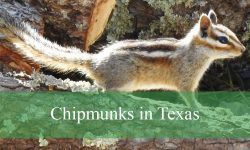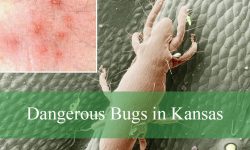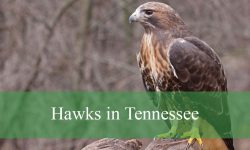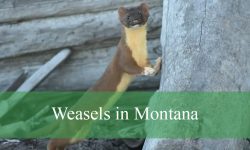If you want to learn about Kansas wildlife, weasels are among the most fascinating small predators to observe. Known for their agility, sharp senses, and stealth, they play an important role in controlling rodent populations.
These elusive mammals inhabit a range of environments, from open grasslands and farmland to forests and wetlands. Each species has unique adaptations that allow it to thrive in its preferred habitat.
By understanding their behavior, diet, and where they are most likely to appear, wildlife enthusiasts can increase their chances of spotting weasels in the wild and gain a deeper appreciation for Kansas’s ecosystems.
Types of Weasels Found in Kansas
Long-tailed Weasel (Neogale frenata)

The long-tailed weasel is one of the most common weasel species in Kansas, easily recognized by its slender body, reddish-brown fur on the back, and creamy white underbelly. Adults typically measure 10–16 inches in body length with a 5–7 inch tail tipped with black, making it one of the more distinctive small mammals in the region. Their long, agile bodies allow them to chase prey into burrows and tight spaces.
Long-tailed weasels are highly active predators, feeding primarily on rodents, rabbits, birds, and occasionally insects. They are known for their remarkable hunting skills, including their ability to kill prey larger than themselves. Their high metabolism requires them to hunt almost daily, and they often cache food for later consumption.
These weasels are versatile in habitat selection. In Kansas, they inhabit grasslands, farmland, forests, and edges of wetlands. They are also occasionally seen near human settlements where prey is abundant, such as barns and grain storage areas. Their adaptability allows them to thrive in both rural and semi-urban environments.
Long-tailed weasels are mainly solitary animals, with territories often maintained by scent marking. They are most active during dawn and dusk, but can also hunt at night. Breeding occurs once a year, and females may give birth to 4–12 kits after a gestation period of approximately 280 days due to delayed implantation.
The best time to observe long-tailed weasels in Kansas is during early spring and fall when their hunting activity is high. Look for them near fields and woodland edges. Signs of their presence include small tracks, scat, and occasional sightings during low-light hours.
Least Weasel (Mustela nivalis)
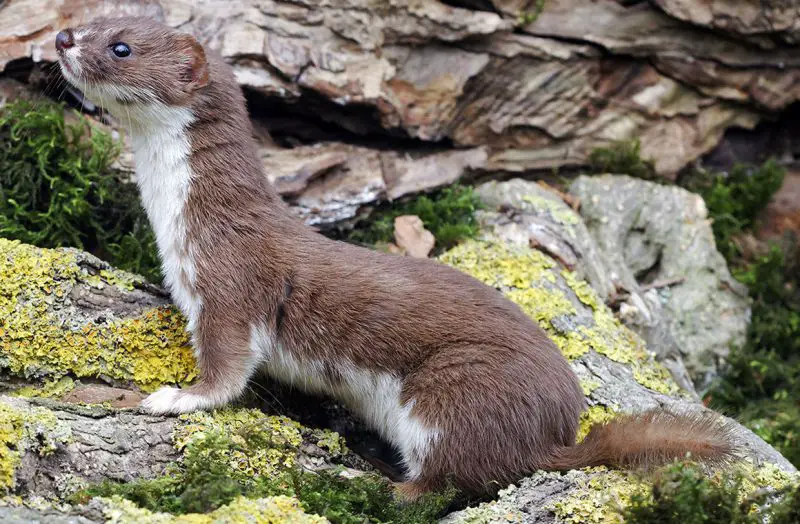
The least weasel is the smallest member of the weasel family in Kansas, measuring just 6–10 inches in length with a tail under 2 inches long. Its coat is reddish-brown above with a white or cream-colored belly. During winter, northern populations may turn white, blending with snow, though in Kansas, this is less common due to milder winters.
Least weasels are fierce hunters despite their small size, preying primarily on mice, voles, and other small rodents. They are capable of entering narrow burrows to reach their prey and are known for their incredible agility and speed. A single weasel may kill several times its body weight in prey weekly.
These weasels favor grasslands, agricultural fields, and edges of woodlands, where rodent populations are dense. Kansas farmlands provide ideal conditions, with abundant food and cover for nesting and hiding. They often occupy burrows abandoned by other small mammals.
Behaviorally, least weasels are solitary and highly territorial. They are active year-round and mostly nocturnal, though daytime activity is sometimes observed. Breeding occurs once annually, and females give birth to 3–8 kits per litter in sheltered nests lined with fur and vegetation.
Spotting a least weasel in Kansas is challenging due to its small size and secretive nature. The best opportunities are in spring and early summer, near open fields or grassy edges, often revealed by sudden movement or signs of predation on rodents.
Mink (Neogale vison)
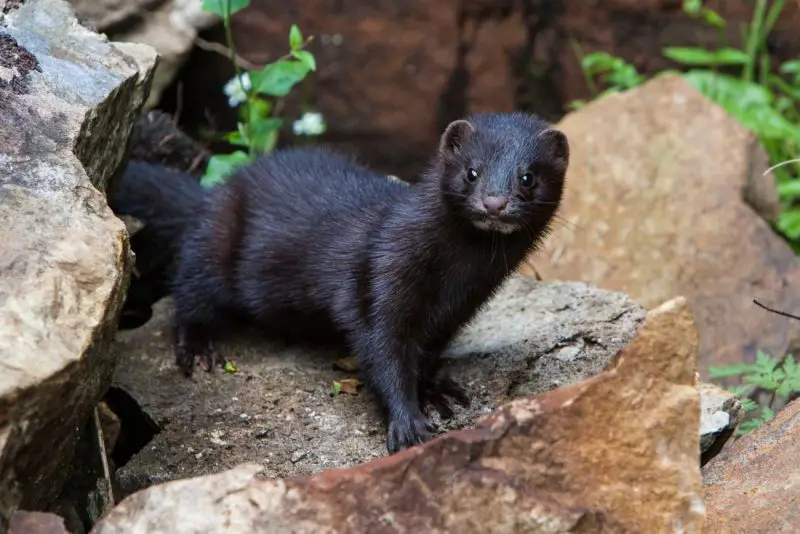
The mink, while often associated with water, is a member of the weasel family and can be found throughout Kansas. It has a sleek, dark brown to black coat with occasional white markings on the chin, throat, or chest. Adult minks measure 14–18 inches in body length with a 7–9 inch tail, making them larger than typical weasels.
Minks are semi-aquatic predators, feeding on fish, amphibians, small mammals, birds, and insects. They are excellent swimmers and hunters in aquatic environments, using both stealth and speed to capture prey. Minks are also known to forage along riverbanks and wetland areas.
In Kansas, minks inhabit rivers, streams, ponds, and wetlands, favoring areas with dense vegetation for cover. They also utilize abandoned burrows or dens for shelter and raise their young in secluded areas near water. These habitats provide both protection and a rich food supply.
Minks are solitary and territorial. They are mostly nocturnal, though daytime activity is occasionally observed. Mating occurs in late winter, and delayed implantation allows females to give birth in spring. Litters typically consist of 4–6 kits.
The best time to observe minks in Kansas is early morning or dusk near rivers and streams. Tracks in mud or along shorelines, as well as fish remains, can indicate their presence. They are more likely to be seen in spring and early summer when young are exploring nearby territories.
Ermine (Mustela erminea)
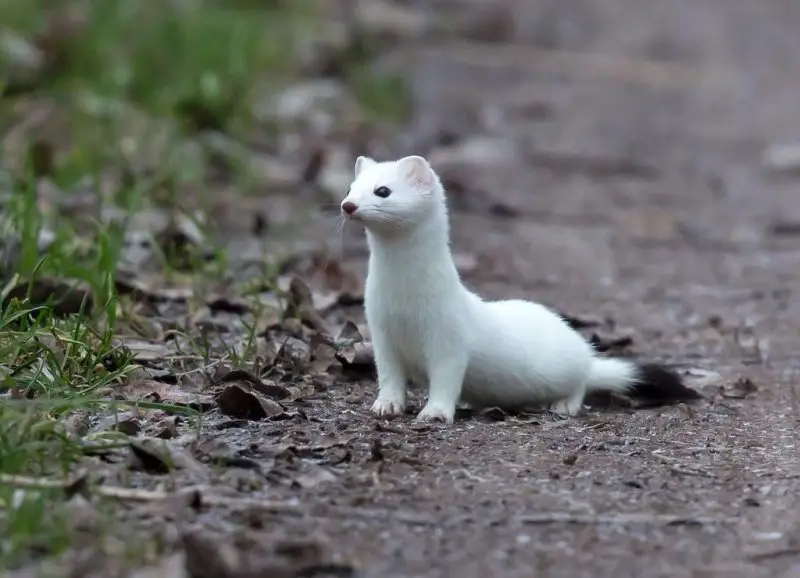
The ermine, or stoat, is closely related to the least weasel and can be identified in Kansas by its long, slender body and black-tipped tail. It typically measures 7–13 inches in body length with a 2–4 inch tail. Kansas populations generally maintain a brown summer coat with a white underbelly, while northern populations molt to pure white in winter.
Ermines are carnivorous and primarily hunt small mammals, especially voles and mice. Their agility and small size allow them to navigate tunnels and narrow spaces efficiently. Like other weasels, they have a high metabolism and require frequent feeding.
In Kansas, ermines are found in grasslands, farmlands, and edges of woodlands. They favor areas with dense vegetation that provides cover for hunting and nesting. Sheltered burrows are commonly used for raising young.
These weasels are solitary and territorial, exhibiting strong hunting instincts both day and night. Breeding occurs annually, and females produce 5–12 kits per litter. They are highly adaptable to seasonal changes in prey availability.
Observing ermines in Kansas is rare due to their secretive nature. Early spring, when vegetation is low and prey is abundant, is the optimal time. Watch near fields, hedgerows, and along the edges of wooded areas for subtle movements or signs of predation.
Kansas Weasels Comparison
Feature |
Long-tailed Weasel (Neogale frenata) |
Least Weasel (Mustela nivalis) |
Mink (Neogale vison) |
Ermine (Mustela erminea) |
|---|---|---|---|---|
Size (Body + Tail) |
10–16 in + 5–7 in |
6–10 in +
| 14–18 in + 7–9 in |
7–13 in + 2–4 in |
Habitat |
Grasslands, forests, farmland, wetland edges |
Grasslands, farmlands, woodland edges |
Rivers, streams, ponds, wetlands |
Grasslands, farmlands, woodland edges |
Diet |
Rodents, rabbits, birds, insects |
Mice, voles, small rodents |
Fish, amphibians, small mammals, birds, insects |
Small mammals (voles, mice) |
Best Time & Place to Observe |
Early spring & fall near fields, woodland edges, or barns |
Spring & early summer near open fields or grassy edges |
Early morning or dusk near rivers & streams, spring & early summer |
Early spring near fields, hedgerows, and wooded edges |
Best Time and Places to Observe Weasels in Kansas
Weasels in Kansas are secretive and primarily nocturnal, but there are specific times and locations where sightings are more likely. Early spring and fall are the best seasons to observe them, as they are actively hunting to replenish energy after winter or in preparation for winter.
Long-tailed weasels are often spotted near fields, woodland edges, and farmland, especially close to barns or abandoned structures where small rodents are abundant. Their elongated bodies and agility allow them to navigate open fields and dense vegetation efficiently.
Least weasels prefer grasslands and open fields, particularly near areas with dense rodent populations. Look for sudden movements in grassy edges or signs of predation on mice and voles.
Minks, being semi-aquatic, are best observed along rivers, streams, ponds, and wetlands, particularly at dawn or dusk when they hunt fish, amphibians, and small mammals. Tracks along muddy banks or fish remains may indicate their presence.
Ermines can be observed near fields, hedgerows, and woodland edges during early spring, when prey is abundant and vegetation is low. Their small size and stealth make sightings rare, so patience and careful observation are essential.
FAQs about Weasels in Kansas
What types of weasels live in Kansas?
Kansas is home to four main types of weasels: Long-tailed Weasel, Least Weasel, Mink, and Ermine. Each species has distinct size, habitat, and diet preferences.
Are weasels dangerous to humans?
Weasels are not considered dangerous to humans. They are small predators that primarily hunt rodents, birds, and insects. However, they can bite if threatened or handled.
When is the best time to spot weasels?
Early spring and fall offer the highest chance of spotting weasels due to increased hunting activity. Minks are most active at dawn or dusk, while other species may also be seen during the day in areas with high prey density.
Where should I look for weasels in Kansas?
-
Long-tailed Weasel: fields, woodland edges, barns, and farmland
-
Least Weasel: open fields, grassy edges, farmlands
-
Mink: rivers, streams, ponds, wetlands
-
Ermine: fields, hedgerows, woodland edges
How can I tell different weasels apart?
Key identifiers include size, tail length, coat color, and habitat. For example, the long-tailed weasel is larger with a black-tipped tail, while the least weasel is tiny with a short tail. Minks are dark and semi-aquatic, and ermines have a black-tipped tail with a slender body.

